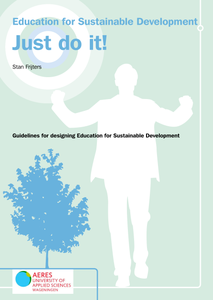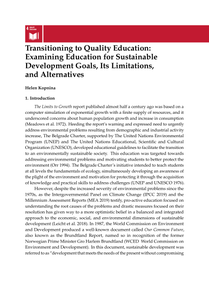Een kennisclip over de Sustainable Development Goals
VIDEO
The study of moral reasoning in relation to sustainable development is an emerging field within environmental education (EE) and education for sustainable development (ESD). The vignette method was used to evaluate the perception of the relationship between environmental and social issues in the Dutch upper elementary school children. This case study is placed within two broad areas of tension, namely between the need to address urgent environmental problems and to promote pluralistic democratic learning; and between the value of environment as an economic asset and deep ecology perspective. Results of this study indicate that the children are able to critically think about the moral dilemmas inherent in sustainable development and distinguish between different values in relation to environment. https://doi.org/10.1016/j.stueduc.2013.12.004 https://www.linkedin.com/in/helenkopnina/
MULTIFILE

With the emergence of education for sustainable development (ESD), robust literature on ethics and ESD has emerged; however, ecocentric perspective developed within environmental ethics is marginalized in current ESDebate. The questions discussed in this article are as follows: Why is the distinction between anthropocentric and ecocentric view of environment salient to ESD? How can this distinction be operationalized and measured? Until now, little has been done to address complement quantitative studies of environmental attitudes by qualitative studies, exploring the sociocultural context in which ecocentric or anthropocentric attitudes are being formed. Neither of existing scales engaged with the interface between environmental ethics and sustainable development. This article will discuss ESD in the context of environmental ethics and present the results of the case study conducted with the Dutch Bachelor-level students. Results of qualitative evaluation of the scale measuring ecocentric and anthropocentric attitudes will be presented, and the new Ecocentric and Anthropocentric Attitudes toward the Sustainable Development (EAATSD) scale will be proposed.
DOCUMENT

Sustainable development has become a crucial part of our modern society and our education. Sustainability is a complex concept. After all, what is considered sustainable to us now may not necessarily be so in the future. We need to continually review our judgments with regards to sustainability. Education for Sustainable Development is about knowledge, attitude, behaviour and values, in which the relationship between a social, an ecological and an economic perspective is always factored in. But what does this education look like? Education for Sustainable Development. Just do it! was the motto for the practice-oriented study by Aeres University of Applied Sciences Wageningen, involving four schools and two universities. This publication describes the theoretical principles of Education for Sustainable Development and the design criteria as were used in this practice-oriented study. This publication describes the theoretical principles of Education for Sustainable Development and the design criteria as were used in this practice-oriented study. These design criteria can help us develop and implement Education for Sustainable Development.
DOCUMENT

This article will discuss social, environmental, and ecological justice in education for sustainable development (ESD) and Education for Sustainable Development Goals (ESDG). The concept of sustainable development and, by extension, the ESD, places heavy emphasis on the economic and social aspects of sustainability. However, the ESD falls short of recognizing ecological justice, or recognition that nonhumans also have a right to exist and flourish. An intervention in the form of an undergraduate course titled Politics, Business, and Environment (PBE) will be discussed. As part of this course, students were asked to reflect on the three pillars of sustainable development: society, economy, and environment, linking these to the fourth concept, ecological justice or biospheric egalitarianism. Biospheric egalitarianism is characterized by the recognition of intrinsic value in the environment and is defined as concern about justice for the environment. Some of the resulting exam answers are analyzed, demonstrating students’ ability to recognize the moral and pragmatic limitations of the anthropocentric approach to justice. This analysis presents ways forward in thinking about the role of “ecological justice” as the ultimate bottom line upon which both society and economy are based. https://doi.org/10.3390/educsci10100261 LinkedIn: https://www.linkedin.com/in/helenkopnina/
MULTIFILE

There are over 1400 age-friendly cities and communities worldwide, and the efforts to create a better quality of life for older people progressively intersect with sustainability goals. The intentions and behaviours concerning sustainability among older are, however, not yet well understood. Therefore, there is a need for assessing these intentions and behaviours through the use of a transparently constructed and validated instrument which can be used to measures the construct of environmental sustainability among older people. The aim of this study is to develop a questionnaire measuring how older people view the theme of environmental sustainability in their daily lives, with a focus on the built environment, providing full transparency and reproducibility. The process of development and validation of the SustainABLE-16 Questionnaire followed the COSMIN protocol, and has been conducted in five phases. This rigorous process has resulted in a valid, psychometrically sound, comprehensive 16-item questionnaire. This instrument can be applied to assess older people's beliefs, behaviours and financial aspects regarding environmental sustainability in their lives. The SustainABLE-16 Questionnaire was created in Dutch and in British English.
MULTIFILE

Neoliberal discourse often conceptualizes nature in relation to its market utility and economic development. This article will address the role of metaphors in shaping neoliberal discourse in business education. The aim of this article is to reveal reasoning patterns about environmental problems and economic development in students of sustainable business minor. The case study described in this article involves business students at The Hague University in The Netherlands. This case study aimed to explore a shift in student understanding of environmental problems and economic development before and after the intervention. The results suggest that critical curriculum can inform students about the alternative conceptions as well as instruct them about potential solutions to the sustainability challenges. The article culminates with the argument that without goal-oriented education for sustainability; neoliberal education may not permit transcendence from unsustainable practices. https://doi.org/10.3390/su6117496 https://www.linkedin.com/in/helenkopnina/
MULTIFILE

This paper consolidates the fragmented literature and evidence by highlighting the three important lenses on the institutional antecedents of sustainable development agenda in cultural heritage tourism. Our study, therefore, identifies three distinct institutional antecedents olensesf sustainable development in cultural heritage tourism such as governance mechanisms, community agency, and the influence of supranational institutions. It demonstrates that sustainable cultural heritage tourism is multidimensional as it spans institutional and sectoral domains. This study brings to light the interplay of these elements and further evaluates their efficacy in embedding the sustainable development agenda in cultural heritage tourism. It also contributes to the literature by bringing to light the current state of the literature on institutional antecedents of sustainable development in cultural heritage tourism. This allows our study to attempt to show the scope of the current knowledge about institutional antecedents and their relationship with sustainable cultural heritage tourism. Most importantly, the study identifies gaps in the research on institutional antecedents and sustainable cultural heritage tourism—the basis on which future research directions have been identified and suggested.
DOCUMENT
Despite the willingness of many educational institutions worldwide to embrace Education for Sustainable Development and Education for Sustainable Development Goals, critical scholars have pointed out that the very enterprise of sustainable development is not without its contradictions. Therefore, any education that engages with sustainable development needs to be carefully reviewed, rather than supported, in its ambition to promote the supposedly universally desirable aims. The rhetoric of sustainable development as meeting the needs of present and future generations is largely anthropocentric in failing to take nonhuman species into account when setting up pragmatic and ethical objectives. Similarly to the Millennium Development Goals (MDGs) that have helped to raise living standards across the world, but have largely failed to address environmental sustainability challenges, the Sustainability Development Goals (SDGs) tend to prioritize “inclusive economic growth” at the expense of ecological integrity, which is very likely to negatively affect not only nonhuman species but also future generations and their quality of life. Thus, as this chapter will argue, universally applicable Education for Sustainable Development Goals (ESDGs) is problematic in the context of addressing the long-term sustainability for both human and nonhuman inhabitants of the planet. Given escalating climate change, biodiversity loss, pollution, and depletion of natural resources, this chapter questions whether ESDGs can qualify as a desirable “quality education”. The paradoxes of sustainable development and ways forward that seem a better alternative for ESDG include indigenous/traditional learning, ecopedagogy, ecocentric education, and education for degrowth, steady-state, and Cradle-to-Cradle and circular economy. Advantages of universal education are also highlighted, as any education that supports basic literacy, numeracy, and values attributed to the intrinsic rights of humans and nonhumans can help students to be equipped to deal with social and environmental challenges. https://doi.org/10.3390/books978-3-03897-893-0-1 LinkedIn: https://www.linkedin.com/in/helenkopnina/
MULTIFILE
